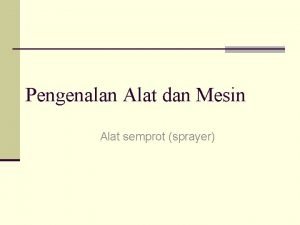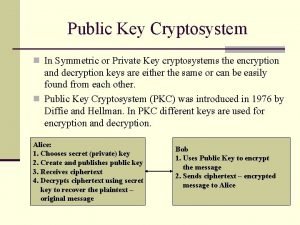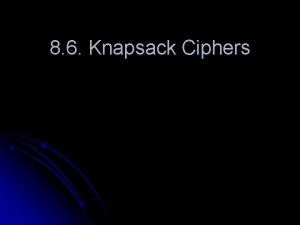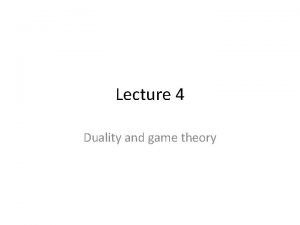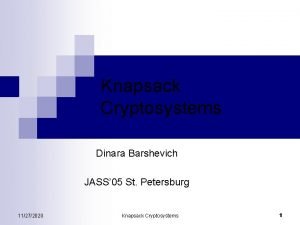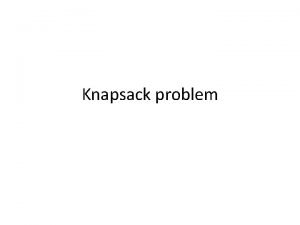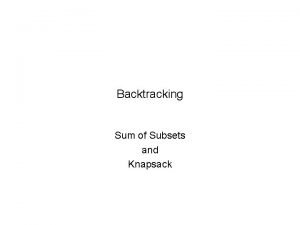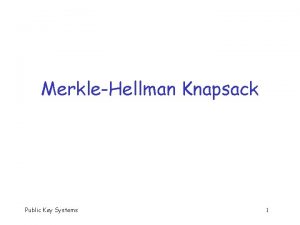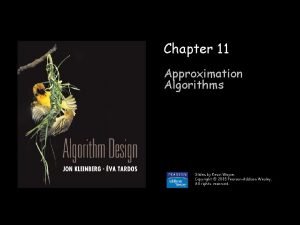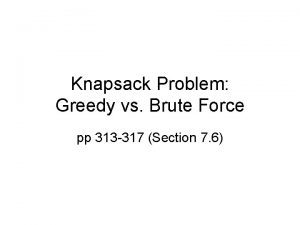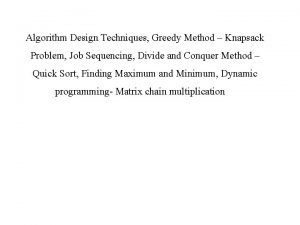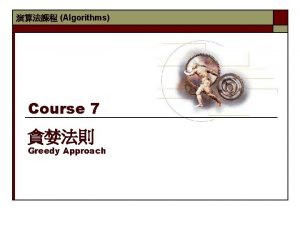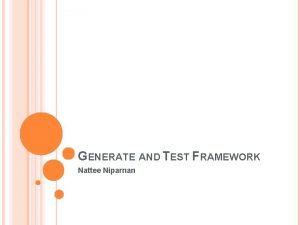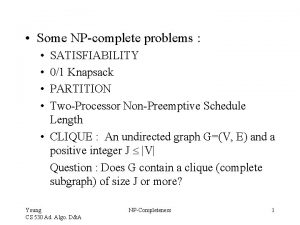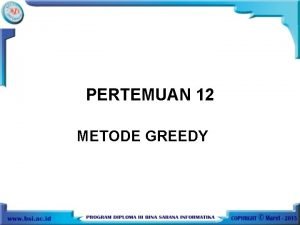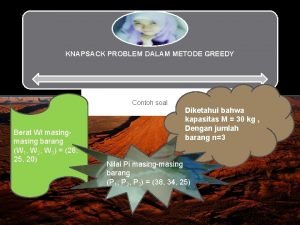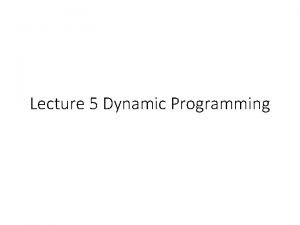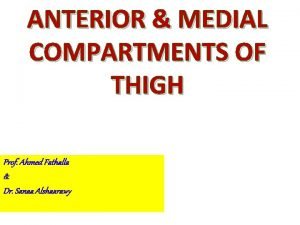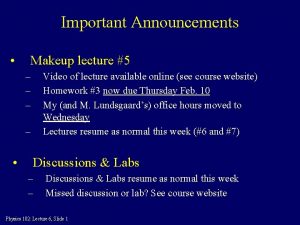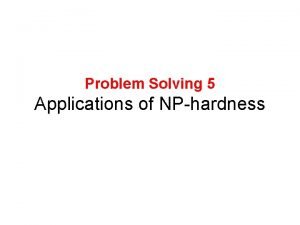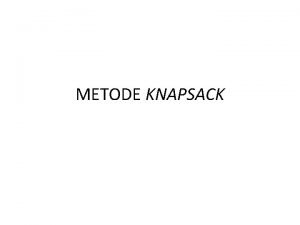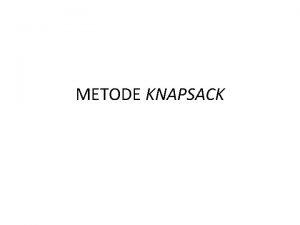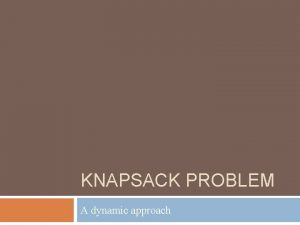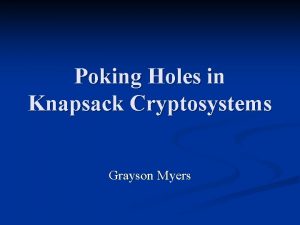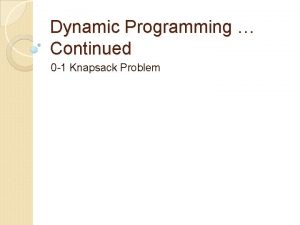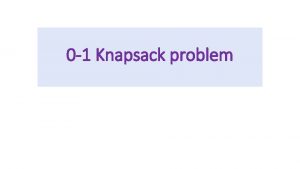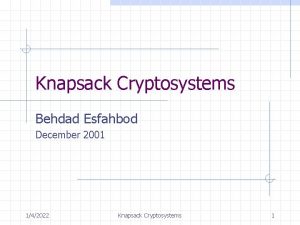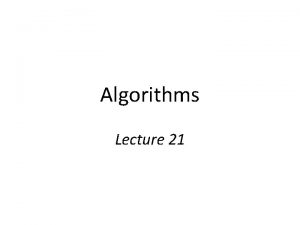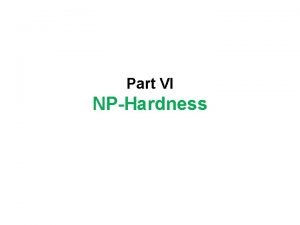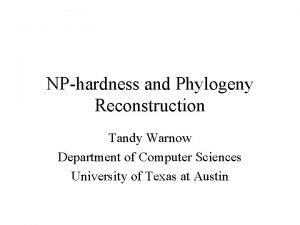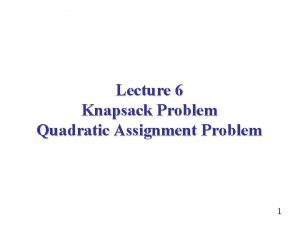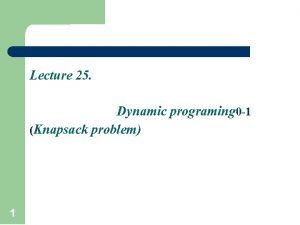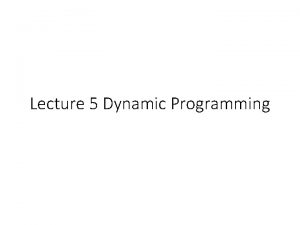Lecture 2 5 Applications of NPhardness Knapsack Knapsack



































- Slides: 35

Lecture 2 -5 Applications of NP-hardness

Knapsack

Knapsack

Knapsack is NP-hard

Decision Version of Knapsack

Partition

Set-Cover

Set-Cover Given a collection C of subsets of a set X, find a minimum subcollection C’ of C such that every element of X appears in a subset in C’. (Such a C’ is called a setcover. )

Vertex-Cover

Decision Version of Vertex-Cover Decision Version of Set-Cover

Broadcast in Multi-Channel Wireless Networks

Problem

Hitting Set Given a collection C of subsets of a set X, find a minimum subset Y of X such that intersection of Y and S is not empty for every S in C.

Nonunique Probe Selection and Group Testing

DNA Hybridization

Polymerase Chain Reaction (PCR) • cell-free method of DNA cloning Advantages • much faster than cell based method • need very small amount of target DNA Disadvantages • need to synthesize primers • applies only to short DNA fragments(<5 kb)

Preparation of a DNA Library • DNA library: a collection of cloned DNA fragments • usually from a specific organism

DNA Library Screening

Problem • If a probe doesn’t uniquely determine a virus, i. e. , a probe determine a group of viruses, how to select a subset of probes from a given set of probes, in order to be able to find up to d viruses in a blood sample.

Binary Matrix viruses probes p 1 p 2 p 3 pi pt c 1 0 0 1 0. . 0 c 2 c 3 0 0 1 … … … … 0 0 0 0 cj … 0 … 0 … … … … 0 0 0 0 … … cn 0 0 0 … 0 … 1 … 0 … 0 0 0 … 0 … 0 The cell (i, j) contains 1 iff the ith probe hybridizes the jth virus.

Binary Matrix of Example virus probes p 1 p 2 p 3 c 1 1 0 0 c 2 1 0 0 0 1 0 c 3 1 0 0 1 0 1 0 0 1 0 0 0 1 cj 0 0 1 1 0 0 0 1 Observation: All columns are distinct. To identify up to d viruses, all unions of up to d columns should be distinct!

_ d-Separable Matrix viruses probes p 1 p 2 p 3 pi pt c 1 0 0 1 0. . 0 c 2 c 3 cj 0 0 … 0 … 0 1 0 … 0 … 0 … 0 … 0 0 1 … 0 … 0 0 0 … 0 … 1 … 0 … 0 0 0 … 0 … 0 All unions of up to d columns are distinct. Decoding: O(nd) cn


d-Disjunct Matrix c 1 c 2 p 1 0 0 p 2 0 1 p 3 1 0 probes 0 0. . pi 0 0. . pt 0 0 0 … 0 c 3 0 0 0 1 … … 0 0 viruses cj … 0 … 0 … … … … 0 0 0 0 … … cn 0 0 0 … 0 … 1 … 0 … 0 … 0 … Each column is different from the union of every d other columns Decoding: O(n) Remove all clones in negative pools. Remaining clones are all positive.

Nonunique Probe Selection _ • Given a binary matrix, find a d-separable submatrix with the same number of columns and the minimum number of rows. • Given a binary matrix, find a d-disjunct submatrix with the same number of columns and the minimum number of rows. • Given a binary matrix, find a d-separable submatrix with the same number of columns and the minimum number of rows

Complexity? • All three problems may not be in NP, why? • Guess a t x n matrix M, verify if M is dseparable (d-separable, d-disjunct).

Problem

- d-Separability Test • Given a matrix M and d, is M d-separable? • It is co-NP-complete.

- d-Separability Test • Given a matrix M and d, is M d-separable? • This is co-NP-complete. (a) It is in co-NP. Guess two samples from space S(n, d). Check if M gives the same test outcome on the two samples.

(b) Reduction from vertexcover • Given a graph G and h > 0, does G have a vertex cover of size at most h?


- d-Separability Test Reduces to d-Separability Test • Put a zero column to M to form a new matrix M* • Then M is d-separable if and only if M* is d -separable.

d-Disjunct Test • Given a matrix M and d, is M d-disjunct? • This is co-NP-complete.

Minimum d-Separable Submatrix • Given a binary matrix, find a d-separable submatrix with minimum number of rows and the same number of columns. • For any fixed d >0, the problem is co-NPhard. • In general, the problem is conjectured to p be Σ 2 –complete.

 01:640:244 lecture notes - lecture 15: plat, idah, farad
01:640:244 lecture notes - lecture 15: plat, idah, farad Gambar knapsack sprayer, dan bagian bagiannya
Gambar knapsack sprayer, dan bagian bagiannya Knapsack problem
Knapsack problem Knapsack cryptosystem
Knapsack cryptosystem Dynamic problem
Dynamic problem Knapsack cipher
Knapsack cipher Knapsack problem excel
Knapsack problem excel Knapsack
Knapsack Problem batohu
Problem batohu State space tree
State space tree Knapsack cryptosystem example
Knapsack cryptosystem example Knapsack
Knapsack Dynamic knapsack algorithm
Dynamic knapsack algorithm Knapsack method
Knapsack method Knapsack problem divide and conquer
Knapsack problem divide and conquer Greedy algorithms
Greedy algorithms Knapsack problem
Knapsack problem Prove knapsack is np complete
Prove knapsack is np complete Optimal tape storage problem
Optimal tape storage problem Contoh soal algoritma greedy dan penyelesaiannya
Contoh soal algoritma greedy dan penyelesaiannya Csci 311
Csci 311 Greedy algorithm for 0-1 knapsack problem
Greedy algorithm for 0-1 knapsack problem 0-1 배낭문제 백트래킹
0-1 배낭문제 백트래킹 Knapsack dynamic programming pseudocode
Knapsack dynamic programming pseudocode Physical science lecture notes
Physical science lecture notes Environmental sociology lecture notes
Environmental sociology lecture notes Chapter 1 introduction to human resource management
Chapter 1 introduction to human resource management Floor of femoral triangle
Floor of femoral triangle Practical transformer equivalent circuit
Practical transformer equivalent circuit Medical genetics lecture
Medical genetics lecture Microbial physiology and metabolism lecture notes
Microbial physiology and metabolism lecture notes Types of lecture method
Types of lecture method Makeup lecture
Makeup lecture Franck-condon principle slideshow
Franck-condon principle slideshow Forensic psychology lecture
Forensic psychology lecture In this lecture
In this lecture

